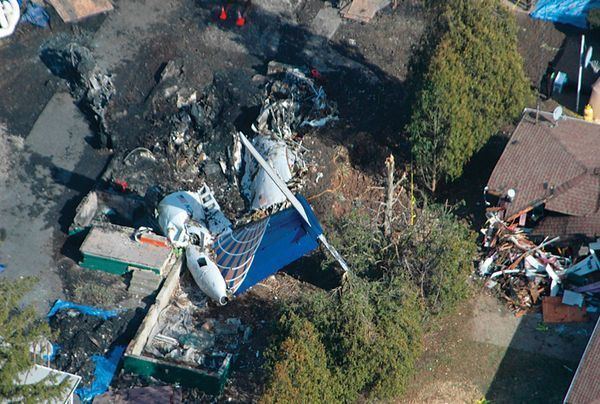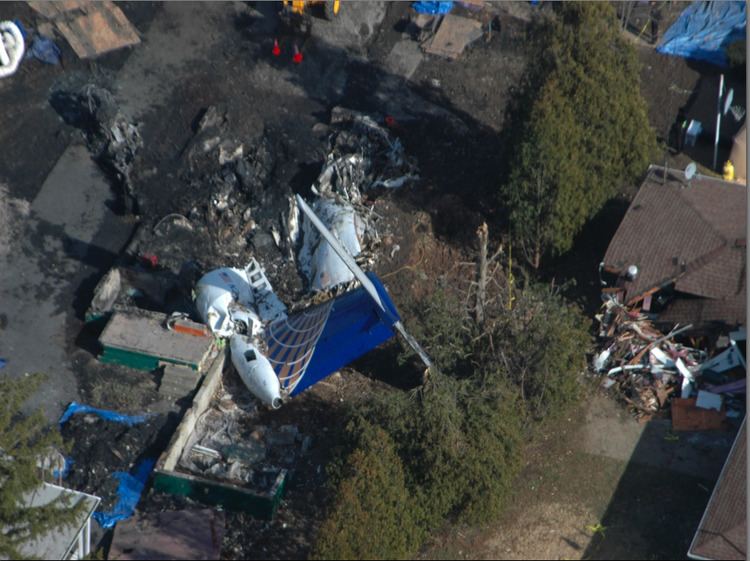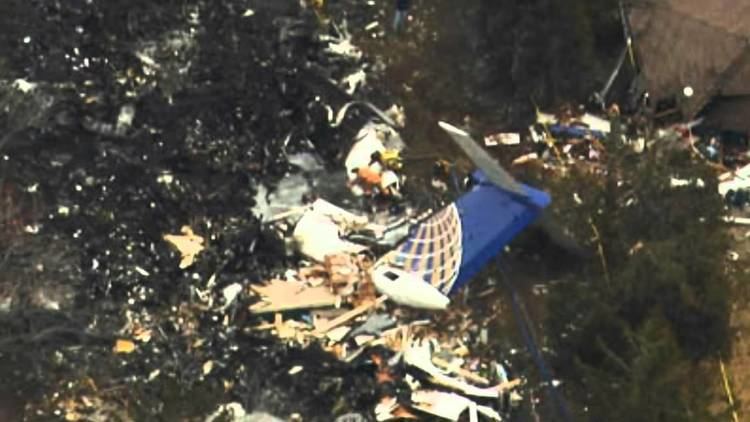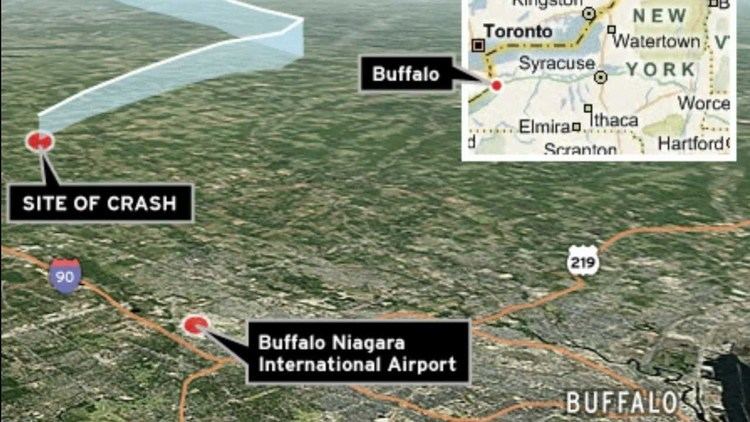Passengers 45 Registration N200WQ Crew count 4 | Injuries (non-fatal) 4 (all on the ground) Date 12 February 2009 Passenger count 45 | |
Summary Stalled during landing approach; crashed into a house Aircraft type Bombardier DHC8-402 Q400 Fatalities 50 (all 49 on board; one on the ground) Similar Turkish Airlines Flight 1951, FedEx Express Flight 80, United Airlines Flight 811, TANS Perú Flight 204, Crossair Flight 3597 | ||
Colgan Air Flight 3407, marketed as Continental Connection under a codeshare agreement with Continental Airlines, was a scheduled passenger flight from Newark, New Jersey, to Buffalo, New York, which crashed on February 12, 2009. The aircraft, a Bombardier Dash-8 Q400, entered an aerodynamic stall from which it did not recover and crashed into a house in Clarence Center, New York at 10:17 p.m. EST (03:17 UTC), killing all 49 passengers and crew on board, as well as one person inside the house.
Contents

The accident triggered a wave of inquiries about the operations of regional airlines in the United States. It was the first fatal airline accident in the U.S. since the crash of Comair Flight 5191 in August 2006, with 49 fatalities.

The National Transportation Safety Board conducted the accident investigation and published a final report on February 2, 2010, which found the probable cause to be the pilots' inappropriate response to the stall warnings.

Families of the accident victims lobbied the U.S. Congress to enact more stringent regulations for regional carriers, and to improve the scrutiny of safe operating procedures and the working conditions of pilots. The Airline safety and Federal Aviation Administrative Extension Act of 2010 required some of these regulation changes.

Flight details
Colgan Air Flight 3407 (9L/CJC 3407) was marketed as Continental Connection Flight 3407. It was delayed two hours, departing at 9:18 p.m. Eastern Standard Time (EST; 02:18 UTC), en route from Newark Liberty International Airport to Buffalo Niagara International Airport.
The twin-engine turboprop Bombardier Dash 8 Q400, FAA registry N200WQ, was manufactured in 2008 for Colgan.
This was the first fatal accident for a Colgan Air passenger flight since the company was founded in 1991. One previous ferry flight (no passengers) crashed offshore of Massachusetts in August 2003, killing both of the crew on board. The only prior accident involving a Colgan Air passenger flight occurred at LaGuardia Airport, when another plane collided with the Colgan aircraft while taxiing, resulting in minor injuries to a flight attendant.
Captain Marvin Renslow, 47, of Lutz, Florida, was the pilot in command, and Rebecca Lynne Shaw, 24, of Maple Valley, Washington, served as the first officer. There were two flight attendants: Matilda Quintero and Donna Prisco.
Captain Renslow was hired in September 2005 and had accumulated 3,379 total flight hours, with 111 hours as captain on the Q400. First officer Shaw was hired in January 2008, and had 2,244 hours, 774 of them in turbine aircraft including the Q400.
There were 2 Canadians, 1 Chinese, and 1 Israeli passengers on board. The remaining 46, including the crew members, were American.
Crash
Shortly after the flight was cleared for the runway 23 instrument landing system approach to Buffalo Niagara International Airport, it disappeared from radar. The weather consisted of a wintry mix of light snow, fog and wind of 15 knots. The de-icing system had been turned on 11 minutes after takeoff. Shortly before the crash, the pilots discussed significant ice buildup on the aircraft's wings and windshield. Two other aircraft reported icing conditions around the time of the crash.
The last radio transmission from the flight occurred when the first officer acknowledged a routine instruction to change to tower frequency. The plane was 3.0 miles (4.8 km) northeast of the radio beacon KLUMP (see diagram) at that time. The crash occurred 41 seconds after that last transmission. Since ATC approach control was unable to get any further response from the flight, the assistance of Delta Air Lines Flight 1998 and US Airways Flight 1452 was requested. Neither was able to spot the missing plane.
Following the clearance for final approach, landing gear and flaps (5 degrees) were extended. The flight data recorder (FDR) indicated the airspeed had slowed to 145 knots (269 km/h). The captain then called for the flaps to be increased to 15 degrees. The airspeed continued to slow to 135 knots (250 km/h). Six seconds later, the aircraft's stick shaker activated, warning of an impending stall as the speed continued to slow to 131 knots (243 km/h). The captain responded by abruptly pulling back on the control column, followed by increasing thrust to 75% power, instead of lowering the nose and applying full power, which was the proper stall recovery technique. That improper action pitched the nose up even further, increasing both the g-load and the stall speed. The stick pusher activated ("The Q400 stick pusher applies an airplane-nose-down control column input to decrease the wing angle-of-attack [AOA] after an aerodynamic stall"), but the captain overrode the stick pusher and continued pulling back on the control column. The first officer retracted the flaps without consulting the captain, making recovery even more difficult.
In its final moments, the aircraft pitched up 31 degrees, then pitched down 25 degrees, then rolled left 46 degrees and snapped back to the right at 105 degrees. Occupants aboard experienced forces estimated at nearly twice that of gravity. The crew made no emergency declaration as they rapidly lost altitude and crashed into a private home at 6038 Long Street, about 5 miles (8.0 km) from the end of the runway, with the nose pointed away from the airport. The aircraft burst into flames as the fuel tanks ruptured on impact, destroying the house of Douglas and Karen Wielinski, and most of the plane. Douglas was killed; his wife Karen and their daughter Jill managed to escape with minor injuries. There was very little damage to surrounding homes, even though the lots in that area are only 60 feet (18.3 meters) wide. The home was close to the Clarence Center Fire Company, so emergency personnel were able to respond quickly. Two of the firefighters were injured. Twelve nearby houses were evacuated.
Victims
A total of 50 people died, including the 49 passengers and crew on board when the aircraft was destroyed, and one resident of the house that was struck. There were four injuries on the ground, including two other people inside the home at the time of the crash. Among the dead were:
Reactions
Investigation
The U.S. National Transportation Safety Board (NTSB) began their inquiry on February 13, with a team of 14 investigators. Both the flight data recorder (FDR) and the cockpit voice recorder (CVR) were recovered and analyzed in Washington, D.C.
Data extracted from the FDR revealed the aircraft went through severe pitch and roll oscillations shortly after the extension of flaps and landing gear, which was followed by the activation of the "stick shaker" stall system. The aircraft fell 800 feet (240 m) and then crashed on a northeast heading, opposite of the approach heading to the airport. Occupants experienced increased G-force, estimated to be two times that of gravity, prior to impact.
Freezing temperatures made it difficult to access crash debris. Portable heaters were used to melt ice left in the wake of the firefighting efforts. Human remains were carefully removed, and then finally identified, over a period of several weeks. The cockpit had sustained the greatest impact force, while the main cabin was mostly destroyed by the ensuing fireball. Passengers in the rear section were still strapped in their seats.
The autopilot was in control until it automatically disconnected when the stall warning stick shaker activated. The NTSB found no evidence of severe Icing conditions, which would have required the pilots to fly manually. Colgan recommends pilots fly manually in icing conditions, and requires them to do so in severe icing conditions. In December 2008, the NTSB issued a safety bulletin about the danger of keeping the autopilot engaged during icing conditions. Flying the plane manually was essential to ensure pilots would be able to detect changes in the handling characteristics of the airplane, which are a warning sign of ice accumulation.
After the captain reacted inappropriately to the stick shaker stall warning, the stick pusher activated. As designed, it pushed the nose down when it sensed a stall was imminent, but the captain again reacted improperly and overrode that additional safety device by pulling back again on the control column, causing the plane to stall and crash. Bill Voss, president of Flight Safety Foundation, told USA Today that it sounded like the plane was in "a deep stall situation".
On May 11, 2009, information was released about Captain Renslow's training record. He had failed three "check rides", including some at Gulfstream International in its pay to fly program, and it was suggested that he may not have been adequately trained to respond to the emergency that led to the airplane's fatal descent. Investigators examined possible crew fatigue. The captain appeared to have been at Newark airport overnight, prior to the day of the 9:18 pm departure of the accident flight. The first officer commuted from Seattle to Newark on an overnight flight. These findings during the investigation led the FAA to issue a "Call to Action" for improvements in the practices of regional carriers.
In response to questioning from the NTSB, Colgan Air officials acknowledged both pilots apparently were not paying close attention to the aircraft's instruments and did not properly follow the airline's procedures for handling an impending stall. "I believe Capt. Renslow did have intentions of landing safely at Buffalo, as well as first officer Shaw, but obviously in those last few moments ... the flight instruments were not being monitored, and that's an indication of a lack of situational awareness," said John Barrett, Colgan's director of flight standards.
The official transcript of the crew's communication, obtained from the CVR, as well as an animated depiction of the crash, constructed using data from the FDR, were made available to the public on May 12, 2009. Some of the crew's communication violated federal rules banning nonessential conversation. From May 12 to 14, the NTSB interviewed 20 witnesses of the flight.
On June 3, 2009, the New York Times published an article detailing complaints about Colgan's operations from an FAA inspector who observed test flights in January 2008. As in a previous FAA incident handling other inspectors' complaints, the Colgan inspector's complaints were deferred and the inspector was demoted. The incident is under investigation by the Office of Special Counsel, the agency responsible for U.S. Government federal whistle-blower complaints.
Final report
On February 2, 2010, the NTSB issued its final report, describing its investigation, findings, conclusions and recommendations. The report includes a "Conclusions" section that summarizes the known facts and lists a variety of contributing factors relating to the flight crew. The probable cause was described as:
The captain’s inappropriate response to the activation of the stick shaker, which led to an aerodynamic stall from which the airplane did not recover.
The NTSB further added the following contributing factors:
Contributing to the accident were (1) the flight crew’s failure to monitor airspeed in relation to the rising position of the low-speed cue, (2) the flight crew’s failure to adhere to sterile cockpit procedures, (3) the captain’s failure to effectively manage the flight, and (4) Colgan Air’s inadequate procedures for airspeed selection and management during approaches in icing conditions.
However, the NTSB was unable to determine why the first officer retracted the flaps and suggested that the landing gear should be retracted. The method by which civil aircraft pilots can obtain their licenses was also criticized by the NTSB. It also found that: "The pilots' performance was likely impaired because of fatigue, but the extent of their impairment and the degree to which it contributed to the performance deficiencies that occurred during the flight cannot be conclusively determined."
NTSB Chair Deborah Hersman, while concurring, made it clear she considered fatigue a contributing factor. She compared the twenty years that fatigue has remained on the NTSB's Most wanted list of transportation safety improvements, without getting substantial action on the matter from regulators, to the changes in tolerance for alcohol over the same time period, noting that the performance impacts of fatigue and alcohol were similar.
However, Christopher A. Hart and member Robert L. Sumwalt, III, dissented with the inclusion of fatigue as a contributing factor, on the grounds that there was not enough evidence to support such a conclusion. It was noted that the same kind of pilot errors and standard operating procedure violations had been found in other accidents where fatigue was not a factor.
Legacy
The FAA has proposed or implemented several rule changes as a result of the Flight 3407 accident, in areas ranging from pilot fatigue to Airline Transport Pilot Certificate (ATP) qualifications of up to 1500 hours of flight experience prior to hiring. One of the most significant changes has already taken effect, changing the way examiners grade checkrides in flight simulators during stalls.
Investigators also scrutinized the Practical Test Standards (PTS) for ATP certification, which allowed for an altitude loss of no more than 100 feet (30 m) in a simulated stall. The NTSB theorized that due to this low tolerance in a tested simulation environment, pilots may have come to fear loss of altitude in a stall and thus focused primarily on preventing such a loss, even to the detriment of recovering from the stall itself. New standards subsequently issued by the FAA eliminate any specific altitude loss stipulation, calling instead for "minimal loss of elevation" in a stall. One examiner has told an aviation magazine that he is not allowed to fail any applicant for losing altitude in a simulated stall, so long as the pilot is able to regain the original altitude.
Dramatization
The story of the disaster was featured on the tenth season of Canadian National Geographic Channel show Mayday (known as Air Emergency in the US, Mayday in Ireland and France, and Air Crash Investigation in the rest of world), in the episode entitled "Dead Tired."
